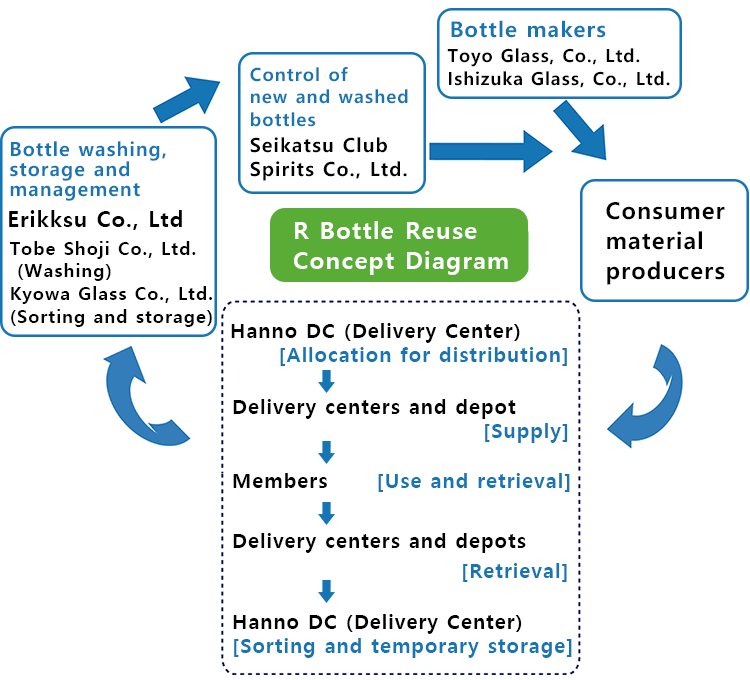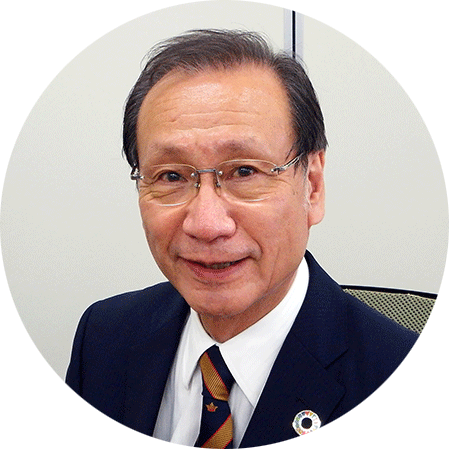The 27 Years of Bottle Reuse is a Social Asset

The Seikatsu Club Consumers’ Co-operative Union (SCCCU) and each of the regional Seikatsu Clubs, in cooperation with other co-operatives, have established a system for retrieving, washing and repeatedly using empty bottles (R bottles) that has been in operation since the 1990s. During this period, Japan’s policy has been to place priority on recycling, and thus the spread of bottle reuse throughout society made little progress. Now that the problem of disposal of single-use plastic containers has become much more serious, society has begun to turn its attention to reuse. Reviewing the performance of the R bottle over this period, we will explore the possibilities for the future.
Attention Focused on Reuse
The use of plastic now pervades every corner of our lives. Due to the increase in single-person households and lifestyle change, the use of plastic materials has increased as food containers have shifted to small-volume and individually packaged items. Meanwhile, against a backdrop of severe environmental crises such as the pollution of the marine environment by plastics and global overheating, a container reuse service started in the United States in May this year, Loop, has also been launched in Japan. The reuse of containers is currently attracting renewed attention, with many large companies also participating.
Putting the three Rs of reduce, reuse, and recycle into practice has been advocated to reduce waste. It is firstly important not to produce waste, but after using some kind of packaging, it should be possible to collect, wash and reuse it, or make use of the resources by converting the article back to its raw materials for recycling.
Considering the energy required for recycling and the amount of carbon dioxide (CO2) emissions involved, Seikatsu Club selected the reuse of bottles as an action that has a smaller environmental load, thus establishing a bottle reuse system in cooperation with other co-operatives. Seikatsu Club has been implementing this system together with partner producers, bottle-washing companies and our members since 1994.
Putting the three Rs of reduce, reuse, and recycle into practice has been advocated to reduce waste. It is firstly important not to produce waste, but after using some kind of packaging, it should be possible to collect, wash and reuse it, or make use of the resources by converting the article back to its raw materials for recycling.
Considering the energy required for recycling and the amount of carbon dioxide (CO2) emissions involved, Seikatsu Club selected the reuse of bottles as an action that has a smaller environmental load, thus establishing a bottle reuse system in cooperation with other co-operatives. Seikatsu Club has been implementing this system together with partner producers, bottle-washing companies and our members since 1994.
The Actual State of Recycling Society
At the same time, policies that prioritize recycling have been promoted in Japanese society. This direction was determined by the enactment of the “Container and Packaging Recycling Law” in 1995. Although the amounts of waste sent to landfills and incinerators decreased due to increased awareness of the need to collect separated waste, the responsibility and cost burden imposed on businesses that use containers and packaging are very moderate, and a large part of the costs are borne by local governments through taxation. According to a 2012 Ministry of the Environment survey, the cost to businesses totaled around 40 billion yen, while the cost to municipalities nationwide of the separation and collection followed by the sorting and storage of container and packaging waste amounted to about 250 billion yen. Many companies consider that the small burden paid to recycle PET bottles is advantageous, and thus the production of these bottles has increased dramatically, currently reaching an annual production of about 23 billion bottles in Japan.
On the other hand, the costs required for recirculation in the case of reuse, retrieval and washing are included in the product price and thus are borne by the business (the consumer). In Japan, there was a long history of bottle reuse that centered on 1.8-liter saké bottles, but the number of businesses using these bottles gradually decreased, and coupled with the decline in the number of liquor stores, which acted as the sales and retrieval spots, the businesses that retrieved and washed bottles also fell into difficulties. Mr. Noboru Tobe, chairman of Tobe Shoji, a company that has been washing bottles for many years, had the following to say about the transition that took place in the reuse society.
“After the high economic growth period of the 1960s, the use of disposable packaging spread and the reuse of bottles declined. It is said that the annual demand for 1.8-liter saké bottles, more than 1.3 billion bottles at its peak, is now about 100 million. The number of bottlers has probably fallen from around 1300 to something like 500.”
On the other hand, the costs required for recirculation in the case of reuse, retrieval and washing are included in the product price and thus are borne by the business (the consumer). In Japan, there was a long history of bottle reuse that centered on 1.8-liter saké bottles, but the number of businesses using these bottles gradually decreased, and coupled with the decline in the number of liquor stores, which acted as the sales and retrieval spots, the businesses that retrieved and washed bottles also fell into difficulties. Mr. Noboru Tobe, chairman of Tobe Shoji, a company that has been washing bottles for many years, had the following to say about the transition that took place in the reuse society.
“After the high economic growth period of the 1960s, the use of disposable packaging spread and the reuse of bottles declined. It is said that the annual demand for 1.8-liter saké bottles, more than 1.3 billion bottles at its peak, is now about 100 million. The number of bottlers has probably fallen from around 1300 to something like 500.”
Practice Becomes an Asset of Society
The “Bottle Reuse Network” established by Seikatsu Club and several other co-operatives started to reuse bottles just at the time when the number of reusable bottles started to decrease. Tobe Shoji Co., Ltd., which has worked with us to support this system, is responsible for the retrieval and washing of the bottles.
“We believe that maintaining and enabling the social recognition of a system such as this to reuse bottles at this scale is a social asset,” says Mr. Tobe. For reuse to be possible, it is important to secure distribution, retrieval and recirculation routes for a certain volume of bottles of the same standard. For 27 years, co-operative members, producers, bottle makers and bottle handlers have worked together to maintain this environment. This is of great significance now that reuse is gaining attention and is gradually spreading throughout society.
Tobe Shoji will refurbish its bottle washing plant in September this year. While making a large capital investment in the current severe environment, Mr. Tobe told us of his feelings by saying, “Now that the world is paying attention to the value of reuse, we have to do it.”
“We believe that maintaining and enabling the social recognition of a system such as this to reuse bottles at this scale is a social asset,” says Mr. Tobe. For reuse to be possible, it is important to secure distribution, retrieval and recirculation routes for a certain volume of bottles of the same standard. For 27 years, co-operative members, producers, bottle makers and bottle handlers have worked together to maintain this environment. This is of great significance now that reuse is gaining attention and is gradually spreading throughout society.
Tobe Shoji will refurbish its bottle washing plant in September this year. While making a large capital investment in the current severe environment, Mr. Tobe told us of his feelings by saying, “Now that the world is paying attention to the value of reuse, we have to do it.”
Many companies are cautious about the use of reusable bottles due to the risk of accidents and hygiene issues. This is also one of the greatest concerns of the partner producers of Seikatsu Club. Mr. Tobe tells us, however, that he wishes to respond to producer concerns by employing the latest equipment.
“Glass is superior to other materials in terms of product preservation and container washing,” says Mr. Tobe. Since bottles are excellent for preventing the odor of previous contents transferring to new contents, they can be used with a variety of foods. Glass is therefore said to be a valuable material that will continue to play a central role in container reuse.
“Glass is superior to other materials in terms of product preservation and container washing,” says Mr. Tobe. Since bottles are excellent for preventing the odor of previous contents transferring to new contents, they can be used with a variety of foods. Glass is therefore said to be a valuable material that will continue to play a central role in container reuse.

Mr. Noboru Tobe, Chairman of Tobe Shoji Co., Ltd.
Toward a Recirculation-oriented Society
SCCCU as a whole uses about 7 million R bottles filled with consumer materials each year, of which around 5 million are retrieved. The retrieval rate of R bottles in FY2020 was 73.6%. The number of new members is increasing due to the coronavirus crisis and because many people are rethinking their lifestyles. This is also an opportunity to convey the meaning of reuse, and each regional Seikatsu Club is planning to hold an “R Bottle Retrieval Campaign” this fall. Mr. Takato Kawai, a member of the SCCCU secretariat, has set a long-term goal of “raising the retrieval rate to 80%.” The higher the recovery rate, the lower both CO2 emissions and the cost will be. More than anything, he said, “We would like many of our members to get a strong sense of the idea that the purchase of consumer materials and the return of containers will lead to the realization of a recirculating-oriented society.”

The 350mlUD bottle is an easy-to-use universal design used for tomato ketchup and other items. Other reused bottles are milk bottles, which have a high retrieval rate of over 90%.
Mr. Tobe of Tobe Shoji Co., Ltd. also said, “Reuse expresses a culture in which you engage in the proper disposal of items you have used. I would like you to reaffirm the significance of your achievements over the past 27 years and continue to expand the number of participants.”
In order to achieve a recirculating-oriented society, it is necessary to further expand our practices thus far throughout society. Policy support to create an environment for reuse is also necessary. Now that there is a growing sense of crisis concerning the global environment, we are increasingly placing our hopes on the reuse of bottles.
In order to achieve a recirculating-oriented society, it is necessary to further expand our practices thus far throughout society. Policy support to create an environment for reuse is also necessary. Now that there is a growing sense of crisis concerning the global environment, we are increasingly placing our hopes on the reuse of bottles.
By Toshiyuki Ushijima
★ Reprinted from the “Seikatsu Club: Sketch of a Dream,” Seikatsu to Jichi, July 2021
Published on July 30, 2021
生活クラブをはじめませんか?
42万人が選ぶ安心食材の宅配生協です
ウェブ加入限定 無料プレゼント






